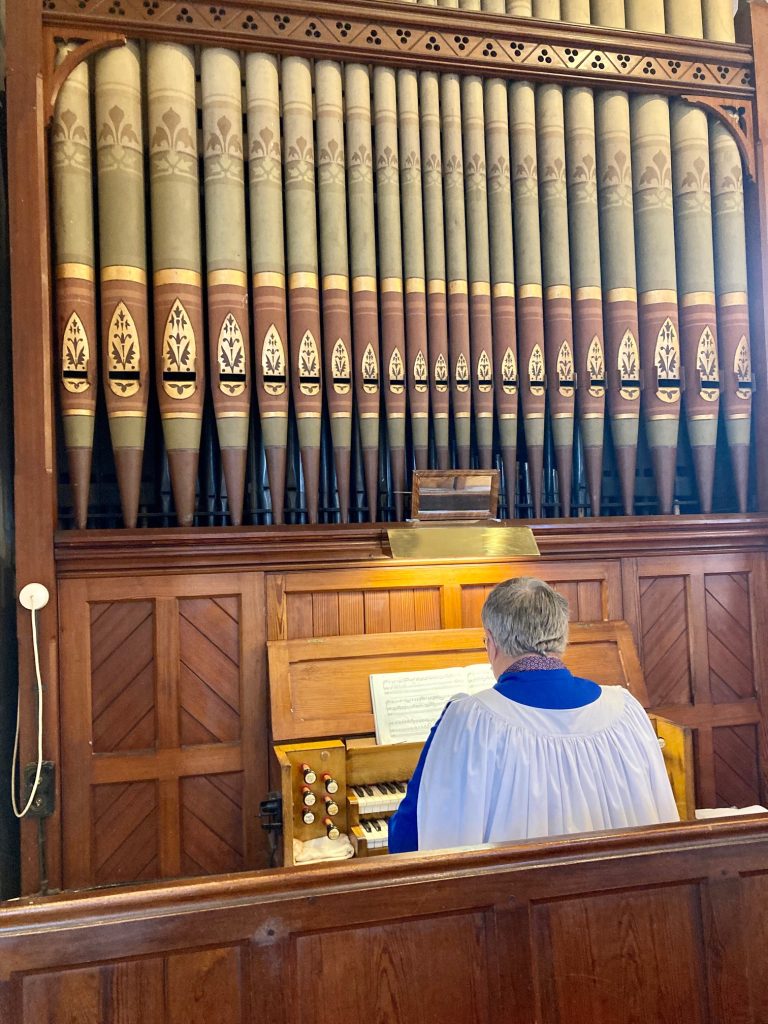If this has piqued your interest, please speak to our Director of Music, Paul Buckmaster who will be delighted to talk to you.
QUESTION: The organ at St James’ was built by the Manchester firm of Jardine, and installed in 1890.
How many pipes do you think it has? See below.

Answer: If you counted the front pipes with the pretty patterns (‘diapered’) and said 21, you’re way off beam! (If you look very carefully, you can see some grey-coloured pipe mouths behind the front display.) Think of each pipe as being like a recorder that can only play one note. The organ at
St James’ has two keyboards for the hands, each of 56 notes, and one of 30 notes for the feet! Each manual keyboard has four sets of pipes, of different shapes, materials, and sizes, to give sounds of different pitches, volume and tones, so in total there are 2 (manuals) x 4 (sets of pipes) x 56 (notes) plus 30 for the feet! But there’s a slight cheat – on the top (‘Swell’) manual, two sets of pipes share one set of the longest 12 pipes to save space. So there are actually ((2 x 4 x 56) -12+30) = 466 pipes!
Question: How long is the longest pipe? How long is the shortest?
Answer: The manual keyboards on the organ at St James go from two octaves below middle C to the G two and a half octaves above middle C. Now, if you want a recorder or whistle to sound middle C, you need one which is about two feet (about 60 cm) from the mouth to the end. So one that sounds two octaves below has to be about eight feet (2.44 metres) from mouth to end. In the above picture, one of those is the third pipe from the left. Organ builders call a set of pipes made so that if you press middle C on the keyboard, middle C sounds, an ‘eight foot stop’. But you can have sets (we call them ‘ranks’, as in ‘rank and file’) of pipes that sound an octave below, or one, two or more octaves above the note you press, for instance to add ‘weight’ or ‘brilliance’ to the sound. St James has five, ‘eight foot’ stops, two ‘four foot’ stops, one ‘two foot’ stop, and a sixteen foot stop for the feet. So the shortest pipe (the top note of the ‘two foot stop’, two and a half octaves above the middle C key, plus two octaves for the change from eight to two feet), is a whistle only two inches (51 mm) from mouth to the top end.
Question: So you would think that the longest pipe on the St James’ organ would be sixteen feet from mouth to the end, sounding three octaves below middle C. But organ builders have at least one way of cheating – how do they do it?
Answer: The answer to the last question is related to how you tune organ pipes. All of the 466 pipes in the St James’ organ have to be tuned periodically – and at the normal temperature too, as changes in temperature and humidity have different effects on different pipes. Just imagine tuning the organ in. for instance, Liverpool Anglican cathedral, which has more than ten thousand pipes – a full time job! At St James’, some (the front ones) are zinc; most of the inner ones are ‘pipe metal’, a soft alloy of tin and lead, like solder. And 154 of them are made of pine wood. To tune a whistle-type pipe, you make the pipe longer or shorter (just like covering / uncovering the finger holes on a recorder.) Some pipes have a slot cut in the back at the top, which can be covered or uncovered. Many of the metal pipes have sprung ‘tin cans’ fitted at the top – these can be moved up or down to make the pipe longer or shorter. But 98 of the wooden pipes have stoppers in the end, that can be moved up or down, like a ‘Swanee Whistle’. A stopped pipe sounds an octave lower than an open pipe of the same length (Paul can explain the physics to you, if you’re interested.) So the lowest note of the 16′ pedal stop actually comes from a stopped wooden pipe, eight feet long, situated in the south east corner of the organ chamber, and sounds at’C’, 32.7 Hz (vibrations per second.) (The Liverpool Cathedral organ has several 32 foot stops, and one that sounds at 64 foot pitch – the bottom note is 8.175 vibrations per second: you can just about count them.
Questions: How else might you ‘cheat’ to get low notes? (The 64′ stop mentioned is one example of this!) And how is air blown through all these pipes to make sounds?
Answers: Have you ever observed that when you play the same note on a piano, a clarinet, a trumpet or a violin (middle C, for instance), they sound completely different? That’s because when you play that note called the ‘fundamental’, the vibrating string or column of air doesn’t only produce that note – but others above it as well, and it’s the number and loudness of those various harmonics that produce the different tone. For instance, an organ pipe which could sound 100 Hz would also produce vibrations at 200 (the octave above), 300 (octave and a fifth), 400 (two octaves), 500 (two octaves and a third), and so on. The distinctive sound of the clarinet (and saxophone – really similar to a brass clarinet) have strong ‘odd-numbered’ harmonics (300, 500, 700 Hz) and weak ‘even-numbered’ harmonics. Your ear is easily deceived. So if you play two pipes at 200 and 300 Hz, your brain says ‘Aha! This sound is being produced by one pipe of 100 Hz.’ especially if the notes are low. So to deceive your brain into thinking you have a 32 foot long whistle sounding 16.35 Hz, you can blow two pipes, one sounding 16.35 x 2 = 32.7 Hz (16 feet long) and another sounding 16.35 x 3 = 49.05 Hz (10′ 8″ long). Ask Paul to demonstrate this to you.
The air to the pipes doesn’t come from 466 people, each playing a one-note recorder at the right time (like hand-bell ringing)! It comes from an electric blower which fills a reservoir, like a big folded bag made of sheepskin, with iron weights on top to produce the pressure (Paul can show you this.) Think of a bagpiper, blowing into his bag and then squeezing it. The ‘wind’ from there goes into big wooden boxes on which all the pipes stand.

The player’s keys, or pedals, and the stop knobs are connected to two-stage valves under each pipe, which ensure that only the pipes that the player wants to sound, do so.
Questions: So why are the ‘stops’ called ‘stops’ and not ‘starts’, if you pull them out to make notes sound? And why, in the illustration of the organ above, is part of it called the ‘Swell’ organ?
Answers: The organ is actually the first keyboard instrument, dating from before the time of Christ (no, St James’ organist was NOT around then!)
A Greek engineer looked at Pan Pipes

and thought that it might be cool to automate them for his wife to play. So he turned them upside down, and fastened them to an empty box. He pumped air into the box using water pressure, but soon realised that all of the pipes would sound at once. Therefore, he made a mechanism so that only the pipes which he (or his wife) wanted to sound, did sound. That’s why we call them ‘stops’ – because they stop all of the ranks of pipes from sounding at once.
One common criticism of the organ is that, being a machine, its sound can, to some, be lifeless. One way of improving this is to enclose some of the pipes in a wooden box with shutters, like a Venitian blind, on the front, that the organist can open or close. This way, the sound can be made to ‘swell’, or to die away. At St James’, all of the pipes controlled by the top manual keyboard (212 of them) are in a box with shutters, and there is a pedal at the right hand end that opens and closes the shutters. The shutters make it harder to tune those pipes – you have to remove some of them to get at the pipes – and you have to remember, after playing, to leave the Swell box open – otherwise the pipes are insulated against changes in the church temperature, and can be very out of tune with the rest of the instrument, next time you play.
Questions: If the organ is the first keyboard instrument, why are some of the keys played with the feet; and how did we get from the organ to the piano and harpsichord?
Answers: The first organs had big levers, hit with the fists, instead of keys! The medieval players of organs were referred to as ‘pulsator organum‘ – ‘organ beaters!’ But as technology got better, the mechanisms became smaller in size, and the keys could be shrunk accordingly. However, bigger pipes, sounding lower notes, still had to have big valves and a larger air supply. Big valves needed more effort to open them (mechanical organ actions do have a ‘pluck’ – you have to overcome the wind pressure that is holding the valve shut), and so big keys, operated by the feet, were supplied for the bigger pipes. So the feet usually play the bass notes, and all organs with pedals have at least one ‘sixteen foot stop’ which sounds an octave below middle C when middle C is pressed.
In the middle ages, stringed instruments were common. Two of these were dulcimer and the zither. Both had wire ‘strings stretched over a box, a bit like the body of a guitar or violin. To play the zither, the strings were plucked with a goose quill, similar to playing a guitar: to play the dulcimer, the strings were hit with small hammers, like playing chime bars, or xylophones. When organ key mechanisms became more advanced, instrument builders applied these to the zither (plucked strings) creating the harpsichord and spinet; and the dulcimer (hit strings), first creating the clavichord, and then the ‘gravicembalo col piano e forte‘: literally the ‘big harpsichord with soft and loud’; not a very catchy name. This was soon shortened to pianoforte (soft-loud), and usually we refer to it as the piano. (When strings are plucked, the amount you can change the volume is quite limited – but when strings are hit, the volume of sound depends on just how hard you hit the strings by bashing the piano keys!)
Question: We’ve seen that the pipes in St. James’ organ are like whistles: are all organ pipes like that, or are there other ways of using air to generate organ sounds?
Answer: Here’s a good illustration of this, and many of the other concepts above, using a local, quite large instrument, in the Bridgewater Hall in Manchester. Enjoy!